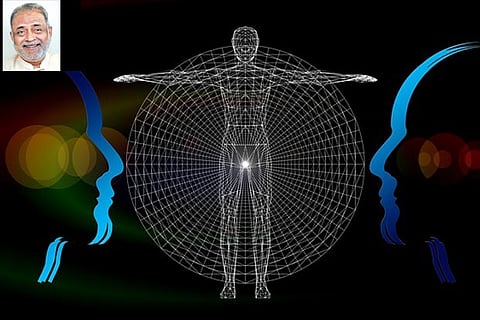

Chennai
There has been so much scientific research in this field, especially during the last 500 years; we have really specialised in this knowledge.
However, this is only one aspect of human anatomy. As we have discussed in previous articles, we have three main bodies – the physical, subtle and causal. Over the centuries, the knowledge of these three bodies has developed and today research in the dynamic field of integrative body-mind-spirit science is unfolding faster than ever before. So, we are better able to understand the dynamics of the physical, subtle and spiritual anatomies. This is the juncture of science and spirituality.
For example, we know that the subtle bodies came into existence for the continuous improvement of consciousness. In other words, they arose for our evolution and they support each other. First of all, it was for the survival of the ‘I’, for our identity. The ‘I’ could not survive without the discrimination of the intellect and the thinking capacity of the mind. These functions of the mind support each other in a coordinated effort for existence and growth.
These subtle bodies can be used for our betterment or for our undoing, as they are functions of the mind that can be used in any way we choose. The purpose of a heart-based meditation practice with transmission is to learn to use them so that consciousness evolves.
Yogis also describe our complex human system in another way: the koshas, sheaths or coverings. In this description, a human being is made up of layer upon layer of coverings, from the outermost to the innermost. The five elements, or pancha bhutas, are yet another way of describing the human makeup – earth, fire, water, air and ether (akasha). Still another classification is that of the seven regions – the heart region, cosmic region, para-cosmic region, prapanna, prapanna-prabhu, prabhu and the central Region.
So, in yoga, a description of human anatomy combines all these things – the elements, points, regions, bodies and sheaths.
Let’s explore what the koshas tell us about consciousness. There are an infinite number of coverings or sheaths in the human system, the densest being the physical at the outside, with progressively finer and finer coverings as we approach the center of our being. They are indicators of the infinite layers of consciousness we potentially have at our disposal. They are usually presented as five main koshas.
The first text describing them is the Taittiriya Upanishad, written around the 6th century BCE, where they are described as lying one inside the other, like the layers of an onion or Russian matryoshka dolls:
Annamaya kosha – physical sheath: Outermost and densest. Combination of the five elements – earth, fire, water, air and ether (akasha). Where we experience the world of matter.
Pranamaya kosha– energy sheath: Where we experience the flow of energy within, and with the world around us.
Manomaya kosha – mental sheath: Where we experience mental activities – thoughts, ideas, reflections, dreams and hopes. Makes use of the mind and the sense organs.
Vignanamaya kosha– wisdom sheath: Knowledge and wisdom sheath. Makes use of the intellect and the sense organs.
Anandamaya kosha–bliss sheath: Innermost sheath around the soul. Here we experience happiness, joy and bliss.
To be contd…
— Kamlesh D Patel is the fourth spiritual Guide in the Sahaj Marg system of Raja Yoga meditation. He is a role model for students of spirituality who seek that perfect blend of eastern heart and western mind. He travels extensively and is at home with people from all backgrounds and walks of life, giving special attention to the youth of today.
Visit news.dtnext.in to explore our interactive epaper!
Download the DT Next app for more exciting features!
Click here for iOS
Click here for Android